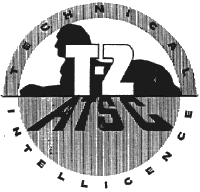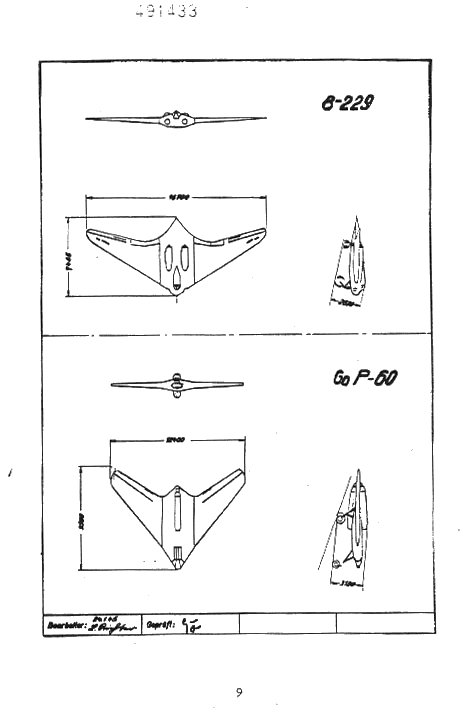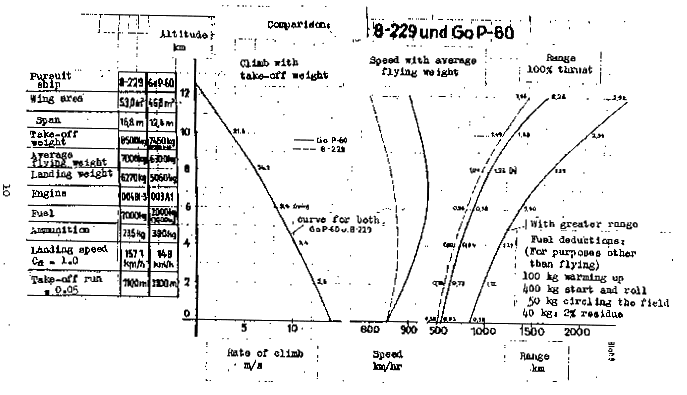
AAF TRANSLATION NO.525 F -TS525- RE
English Title:
COMPARISONS OF THE 8-229 AND THE
GO P-60 ALL-WING AIRPLANES
German Title:
GEGENÜBERSTELLUNG 8-229 GO P-60
Author: Nauber

Date Prepared: Release Date:
21 February 1946 22 April 1946

HEADQUARTERS AIR TECHNICAL SERVICE COMMAND
WRIGHT FIELD, DAYTON, OHIO
| WF-0-24 FEB 46 10M | |
| INTELLIGENCE (T-2) | HEADQUARTERS |
| AIR DOCUMENTS DIVISION | AIR TECHNICAL SERVICE COMMAND |
| TRANSLATION | WRIGHT FIELD, DAYTON, OHIO |
SUBJECT: Translation of Captured Enemy Document
TO: Distribution Listed
1.Attached translation is forwarded for your information and retention.
2.Recipients are invited to forward copies at translations made by the for filing in Reference Library (TSRWF), Air Documents Division, Intelligence (T-2),Hq. ATSC, Wright Field, Dayton, Ohio.
DONALD L. PUTT
Colonel, Air Corps
Deputy Commanding General
Intelligence (T-2)
Incl.
DISTRIBUTION:
1 Original manuscript (German) - Foreign Document
1 Master Copy - Publ. By., Technical Servo. Section (TSRTS-4)
1 Foreign Documents
1 Special Documents
1 TSRTR
1 SNOUT - Analysis Section (T-2)
1 TSILI - Liaison Section, Collection Division
1 Publ. Br., Technical Servs. Section (TSRTS-4)
2 AC/AS-2, AFBAI-1L Attn: Maj. Towle
1 N.A.C.A. 1500 New Hampshire Avenue, Washington, D.C.
2 N.A.C.A., Langley Memorial Aero Lab., Langley Field, Va.
Attn: Maj. D. R. Estman, Jr.
1 N.A.C.A., Ames Aeronautical Lab., Moffett Field, California
1 N.A.C.A., AERL, Cleveland Municipal Airport, Cleveland, Ohio
1 Library of Congress (Division of Aeronautics), Washington, D.C.
1 Institute of Aeronautical Sciences, 1505 RCA Bldg., New York, N.Y.
3 BAGR, BuAas, Gen. Representative, Centr. Dist., Wright Fld., Dayton, Ohio.
1 Society of Automotive Engineers, Aero Div., 29 W. 39th St., New York, N.Y.
1 Commanding General, AAF Center, Orlando, Florida. Attn: AAF School Library.
1 President, AAF Board, Orlando, Florida
1 AAF Scientific Advisory Group, Ch/AS, Hq AAF, Washington 25, D.C.
Attn: Dr. Von Karman
1 Chief, Naval Intelligence, OP-23 7-2, Rm. 4524, Navy Bldg., Washington, D.C.
Attn: J. H. Alberti.
2 Unit Initiating Request TSNNT, Major Smiley
INTELLIGENCE (T-2) HEADQUARTERS
AIR DOCUMENTS DIVISION No. 525 AIR TECHNICAL SERVICE COMMAND TRANSLATION
WRIGHT FIELD, 21 FEBRUARY 1946
COMPARISON OF THE 8-229 AND THE GO P-60
ALL-WING AIRPLANES
By Nauber
------------------------------------------------------------------------
An attempt will be made in this treatise to present a comparison of the two all-wing airplanes, the 8-229 and its further development, the Go P-60, in their most important structural and aerodynamic interpretation.
In order to evaluate the 8-229, the V-6 will be discussed since it comprises all the required installations. It must be stated at this point that, comparatively, the 8-229 will be at a disadvantage, for the V-6 underwent considerable necessary changes compared to the original design, in respect to "aerodynamic and weight deterioration."
The airplanes in question are intended to be used for:
Service as heavy pursuit ships with a crew of 1 or 2 men.
Reconnaissance ships for close or medium range sorties.
A. GENERAL STRUCTURE
| 8-229 | Go P-60 | |
| 1) Arrangement of propulsion unit |
2 x TL 109.004 within the wing close to cockpit (bulges at the entrance and emergence points) | 2 x TL 109.003 a) one TL jet unit each above and below the end of section in center of wing or b) in center of airplane, in the rear, below on the pressure side next to each other. |
| 2) Crew | 1 man sitting (Pressure cabin) | 2 men lying down (Pressure cabin) |
| 3) Landing gear | Arrangement of front wheel.Distribution of load: In front 45%, in the rear 55% of total weight (Bulges in the streamline required.) | Arrangement of front wheel.Distribution of Load: In front 15%, in the rear 85% of total weight. |
| 4) Armament | 4 MK(automatic cannons) 108, each barrel 90 shots or 2 MK(automatic cannons) 103 each barrel 140 shots. | 4 MK(automatic cannons) 108, each barrel 170 shots or 2 MK (automatic cannons) 103, each barrel 175 shots. |
| 5) Fuel | 4 tanks in the outer wing. Altogether 2000 kg of fuel. | One tank in the center wing. In the outer wing 1 tank each: 2000 kg of fuel (In the wing center section there is space for 1000 kg more) |
| 6) Photographic apparatus | 2 RB 50/15 | 2 RB 50/18 |
| 7) Construction | Center wing: tubular frame work with plywood oovering. Outer wing: ribbed construction with reinforced wooden shell (Lattice grate type under construction) | Center wing: tubular framework with plywood covering. Outer wing: wooden wings of lattice grate type. |
| 8) Take-off weight (At equal weight of fuel) | G = 8500 kg (18,739.1 lbs) (incl. 600 kg of ballast) (1322.4 lbs) | G = 7450 kg (16,519.8 lbs) |
| 9) Utilization of other propulsion units. | Installation of TL 003 hardly possible. Installation of TL 011 impossible. | Installation of TL 004 can easily be done. Installation TL 011 can easily be done. |
B. AERODYNAMIC LAYOUT
| 8-229 | Go P-60 | |
| 1) Wing surface | F = 53 m2 (63.38 sq.yd.) | F = 46.8 m2 (55.97 sq.yd.) |
| 2) Entire surface | Fo = 119 m2 (142.32 sq.yd.) | F = 110 m2 (131.56 sq. yd.) (at 262 Fo = 108 m2) (129.168 sq.yd) |
| 3) Aspect ratio | b2/F = 5.2 | b2/F = 3.3 |
| 4) Sweepback | 28 deg | 45 deg |
| 5) Wing sections | Asymmetrical. Standard wing sections. Ratio of maximum thickness: 17.8% (originally 15.5%) |
Symmetrical. High speed wing sections. Ratio of maximum thickness: 13% |
| 6) Elevator and aileron | Frise-control surfaces | Internally balanced control flaps. |
| 7) Directional control | Interceptor- control in 80% of span (planned change in construction: Control by resistance of surface sections being extended outward from the wing in direction of span;slot in outer wing) | On wing tip extendable plates perpendicular to the wing. (presupposition: circulation forces) |
| 8) Elevator and aileron triming | Inner control surfaces in cross position to outer control surfaces by kinematic superimposition (Planned:auxiliary trim tab) | Auxiliary trim tab in the main control surface |
| 9) landing device | Simple trailing edge flap | a) leading edge split flap b) split flap in wing midsection |
| 10) Safety device against tipping | a) slight warping | a) slight warping b) setting up wing sections along the span c) leading edge split flap (alternative: automatic slot) |
| 11) Position of center of gravity and displacement of center of gravity | Maximum permissible backward shift of the
center of gravity at the take-off, attained only with a ballast of 600 kg (1322.4 lbs) (in
reconstructing the wing area, ballast is to be reduced considerably) While landing the center of gravity is shifted forward 7% farther than at take-off |
Position of center of gravity within the
safety region. Displacement of center of gravity slight (~ 1%) |
C. REVIEW OF FLIGHT PERFORMANCES AND FLIGHT CHARACTERISTICS
1.The fact that the two compared airplanes are equipped with different propulsion units must be emphasized before a discussion of flight perfornances can take place. The differences in power caused thereby are practically of importance only at ground level or at low altitudes, and are especially of disadvantage to the Go P-60 since they reduce its power by 2.0 m/s (6.56 ft/sec) on the ground and on the runway by 120 m (393.69 ft). By transferring the propulsion units to the outside and by adopting an arrangement where the pilot is in a lying position, it becomes possible to keep the wing area in a Go P-60, in contrast to 8-229, about 12% smaller and to reduce the maximum thickness of the wing section to 13% as against 17.8%. Beyond that, symmetrical wing sections with a small leading-edge radius and a shift of the bulk of the ship towards the stern (50%) are being used in the Go P-60; also the sweepback is considerable. Because of these measures (small thickness of wing sections, small leading-edge radius, considerable shifting of thickness to the rear, strong sweepback and also small aspect ratios), it is expected that the start of the sharp rise in drag due to the approach of the flight speed to sonic velocity will be shifted in the Go P-60, as against 8-229, to larger Mach numbers (D M ~ 0.1).
The larger induced drag of Go P-60, effected by the lower aspect ratio, causes slight losses in climbing speed and ceiling which, however, is compensated by the smaller loaded weight.
The, additional drag, produced in a Go P-60 by removing the propulsion units from the wing, is partly balanced by the smaller wing area and by using thinner symmetrical wing sections. Beyond that, the magnitude of this additional drag depends largely on the possibility of transferring the propulsion units into the wing. The wing sections selected for Go P-60 are decidedly laminar sections. Should these wing sections still show laminar effects at the large Reynolds numbers with which we deal here, then the attainable cwF-value (without M-influence) in the region of high speed will be smaller than in 8-229. However, since the 8-229 as well as the Go P-60 perform at speeds where sound velocity is approached and where, consequently, a sharp rise in drag must be considered, this drag will decisively influence the maximum flight performances. Consequently, the Go P-60 is expected to show definite advantages over the 8-229.
Flight performances of both airplanes, as plotted in the attached graph, were ascertained under the same basic assumptions [DVL (Deutsche Versuchsanstalt für Luftfahrt) - measurements of wing sections, equal cw - additions for landing gear flaps, control surface slot, good construction of surfaces]; the increase of drag at high Mach numbers was considered according to the high speed measurements of DVL. Shift of the critical M-number by sweepback in the 8-229 was D M = 0.03, in Go P-60, D M = 0.05.
2) Flight characteristics
Since, in high speed airplanes investigated thus far, the dangerous disturbances of stability around the lateral axis start only at M-numbers higher than those at which the sharp rise in drag sets in, it is to be expected that, at least in horizontal flight and climb, the disturbances in the flight characteristics around the lateral axis will also follow the same tendency in tailless aircraft, especially since the outer control surfaces might become "critical" much later because of their thinner air foil sections.
In the Go P-60 as compared with the 8-229, the symmetry, practically one hundred per cent, of suction side and pressure side might show up favorably, since any asymmetry of wing sections or of the over-all structure of an airplane produced stability disturbances around the lateral axis in comparatively early stages of high speed performance.
Since, in tailless aircraft, the directional stability and especially the stability in turning and banking is rather weak, attention will have to be focussed on this problem in discussing these models. In the Go P-60, improvements are expected by placing the propulsion units backward and outward. Special measures have been planned in both airplanes for target approach. In order to increase the stabilizing effect while making a turn the 8-229 extends the air wing brakes, the Go P-60 the wing tip plates which also are used for directional control. However, installation of an automatic target flight control is recommended for both airplanes. Yet, adequate directional stability might be attained by merely installing vertical tail surfaces.
The vertical control surfaces and, consequently, the tactical brake flaps of the 8-229 are liable to present difficulties at high speed as a result of upsetting the entire distribution of pressure along a considerable part of the wing span. In this respect, it may be more favorable to adopt brake surfaces extendable at the wing tip, although the wide gap, forming at the wing tip, is a disadvantage.
An accurate coordination of the controlling components is exceedingly difficult due to the large dimensions of the control surfaces and the high speed of flight, for the required aerodynamic balance of control surface moments must be carried so far that the unavoidable allowances, to be made in production, will make the control, without special measures, practically impossible. In the 8-229 special difficulties might be expected in that respect, chiefly at high velocities, because extreme Frise-type control surfaces were adopted.
In the Go P-60 these difficulties are alleviated by subdividing control surfaces whereby only the smaller outer control surface is directly controlled by the stick, while the main control surface is indirectly controlled by the stick, and moved by a servo-rudder.
Because of the heavy sweepback, stability is assuredly more difficult to achieve in a Go P-60 than in a 8-229. But here, too, satisfactory performance characteristics are to be expected by applying the usual remedies against tipping hazards, such as: the familiar methods of fairing along the span, leading edge split flap, or slot.
The landing of tailless aircraft naturally calls for placing the center of gravity as far to the rear as possible. In the Go P-60 this is done by arranging the landing gear, fuel tanks and ammuntion to that effect; the center of gravity is slightly shifted to the rear when the landing gear is lowered, the fuel tanks become empty and the ammunition is expended. In the 8-229 conditions are less favorable, since fuel, ammunition, and landing gear are disadvantageously arranged in regard to the position of the center of gravity at landing. Compared to the take-off, the situation on landing shows the position of the center of gravity to be further in front (approximately 7% of the reference chord = 200 mm or 7.784 in). The Ca max values still attainable under these circumstances ought to become very small and, consequently, the landing speed will increase considerably.
------------------------------------------------------------------------
Gegenüberstellung 8-229/Go P-60
Gothaer Waggonfabrik, A. G.
Flugzeugbau-Entwicklung
January 27, 1945
7 pp., 2 illus.
Translated by Julius Selimerler
Edited by Dr. Robert Patek
Translation Section, Air Documents Div.
Intelligence (T-2), Wright Field, Dayton, Ohio
This is an AAF translation
21 February 1946
MBR/elk
INTELLIGENCE (T-2) HEADQUARTERS
AIR DOCUMENTS DIVISION AIR TECHNICAL SERVICECOMMAND
TRANSLATION SECTION WRIGHT FIELD, 21 FEBRUARY 1946
COMPARISON OF THE PERFORMANCE, WEIGHT, AND SIZE OF THE GO 8-229 AND GO P-60 All-WING AIRPLANES
------------------------------------------------------------------------
COMPARISON OF WEIGHT IN 8-229-GO-P-60
------------------------------------------------------------------------
| Construction Group | 8-229 | Go P-60 | D G | Proof |
| Outer wing with aileron | 1400 kg (3086.47 lbs.) (34m2) (365.97 sq. ft.)
|
900 kg (1984.16 lbs.) (27.6m2) (297.08 sq.ft.)
|
500 kg (1102.31 lbs.)
|
a) 19% smaller surface - 265 kg (584.22 lbs.). b) other construction type not correctly dimensioned. c) smaller load because of lighter weight. d) small aspect ratio. |
| Center wing | 1110 kg (2447.13 lbs.) (19m2) | 915 kg (2017.23 lbs.) (18.8m2) | 195 kg (429.90 lbs.) | considerably improved static construction. Eccentricities avoided. |
| Power plant | 1735 kg (3825.02 lbs.) | 1570 kg (3461.26 lbs.) | 165 kg (363.76 lbs.) | difference between Jumo and BMW. |
| Ballast | 600 kg (1322.77 lbs.) | _______________ | 600 kg (1322.77 lbs.) | |
| Total armor plating | 400 kg (881.85 lbs.) | 290 kg (639.34 lbs.) | 110 kg (2142.51 lbs.) | ballast armor plate. |
| Landing gear | 345 kg (760.59 lbs.) | 525 kg (1157.43 lbs.) | -180 kg (-396.83 lbs.) | take-over of Ju-88 landing gear; oversized. |
| Ammunition | 210 kg (462.97 lbs.) | 390 kg (859.80 lbs.) | -180 kg (-396.83 lbs.) | |
| Pressure cabin | ______________ | 120 kg (264.55 lbs.) | -120 kg (-264.55 lbs.) |
1090 kg (2403.04 lbs.)
Gegenüberstellung Go-8-229
Go-P-60.
Microfilm Reel 2060 Frame 453
ADRC 14/8A5
3 pp., 2 illus.
Translated by Julius Schmerler
Edited by Dr. Robert Patek
Translation Section, Air Documents Div.
Intelligence (T-2), Wright Field, Dayton, Ohio
This is an AAF translatation
21 February 1946
MBR/elk

